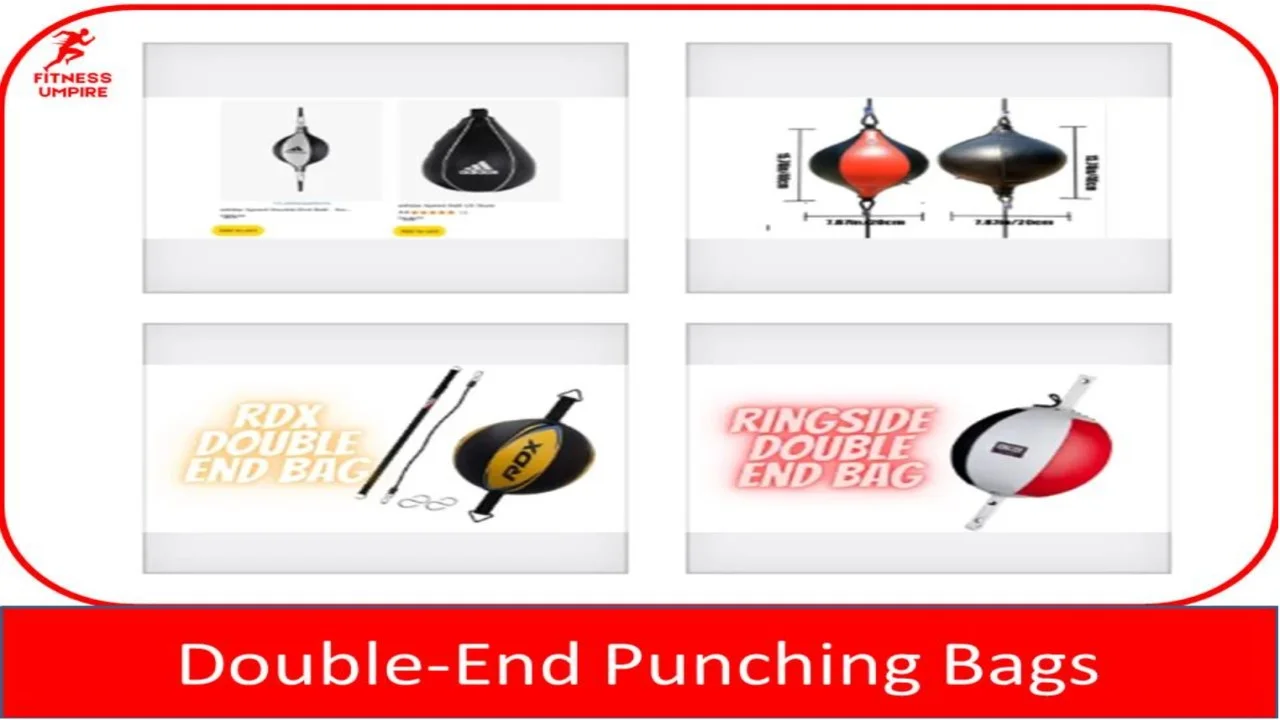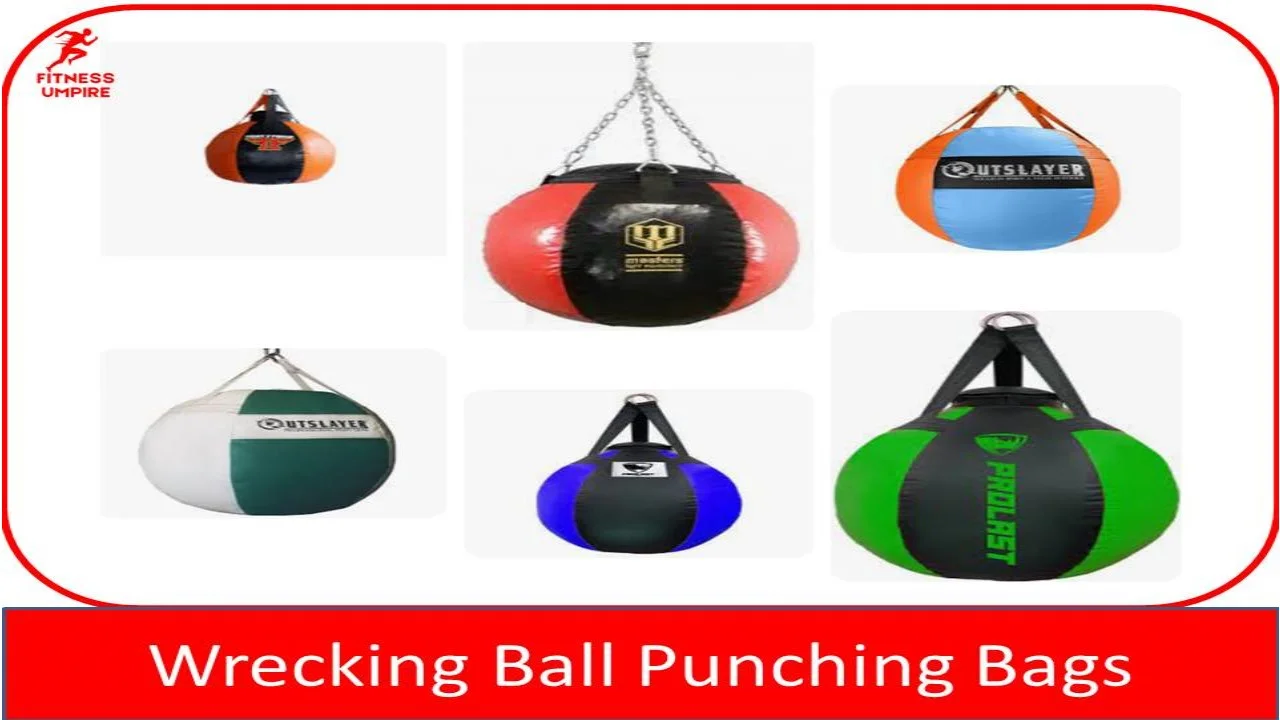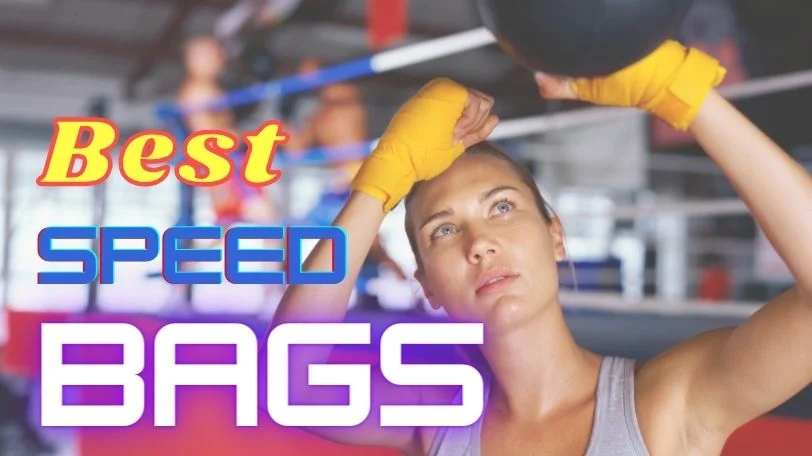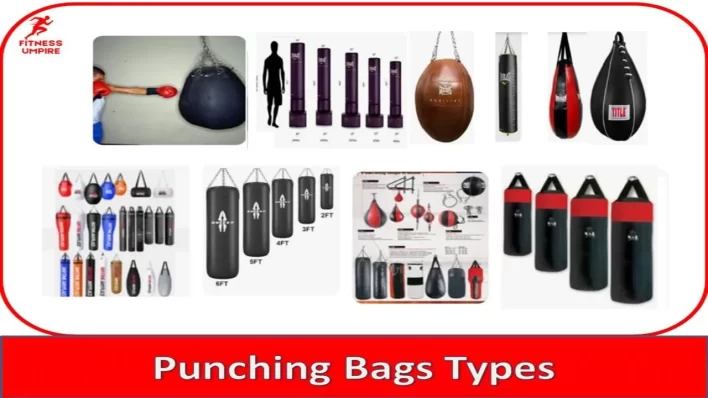
Not all punching bags are created equal! Whether you’re a boxer, MMA fighter, or fitness enthusiast, choosing the right punching bag is essential for maximizing your workouts. But with so many options—heavy bags, speed bags, reflex bags, and more—how do you know which one suits your training needs?
This guide breaks down the best punching bag types, their uses, and who they’re ideal for. Whether you need a power-packed heavy bag for knockout punches or a fast-moving reflex bag to sharpen your defense, we’ve got you covered. Let’s explore which bag will take your training to the next level!
Standard Heavy Hanging Bag -Traditional cylindrical bag for all-around striking
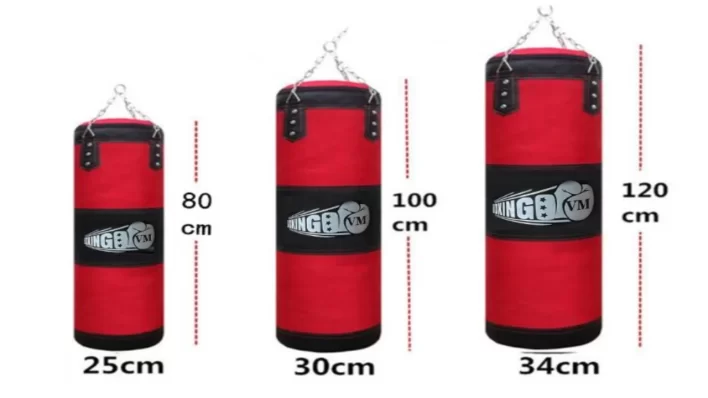
The heavy hanging bag is the gold standard for boxing and martial arts training. Designed for power punches, endurance, and footwork, it absorbs repeated strikes while mimicking real-fight conditions. Available in various weights (70lb, 100lb, 150lb+), these bags help fighters develop strength, precision, and stamina.
Popular models like the Everlast C3 Foam Heavy Bag and Ringside Powerhide Heavy Bag offer high-density padding and tear-resistant material, ensuring long-lasting durability. If you want a full-body striking workout, a heavy bag is a must-have in your training arsenal. For more detail read our complete guide about heavy hanging punching bags types.
It’s maintenance is simple – just wipe clean, check the chain regularly and store in a dry place. Heavy hanging bags priced between $80 and $200 depending type and size, like Banana heavy bag which is long and narrow used by Muay Thai practitioners.
Banana Heavy Bag – Long and narrow, great for low kicks and full-body strikes

The Banana Bag, also known as the Muay Thai Bag, is a long, thin bag used for training low kicks, knee strikes, elbow strikes, and grappling moves.
It comes in 5- and 6-foot sizes, typically weighs 80 pounds to 120 pounds, and is made of heavy-duty synthetic leather with reinforced seams for maximum durability.
A dense foam or sand-filled core ensures shock absorption, reducing excessive swinging while still allowing for realistic movement. Designed for Muay Thai, kickboxing, and MMA fighters, this bag is not meant for pure boxing due to its length and focus on leg techniques.
It is designed to be mounted to the ceiling or wall and is easily cleaned with a damp cloth. Generally priced between $100 and $250, it offers long-term durability and high performance as angled heavy bag provide for serious boxers.
Angled Heavy Bag – Features a wider top for uppercuts and hooks.

The angled heavy bag, also known as a hybrid heavy bag or body punching bag, features a wide top and narrow bottom that simulates an opponent’s torso, waist, and hips.
It’s made of premium synthetic leather with reinforced stitching for durability and shock-absorbing foam to reduce hand stress. It’s available in 80-, 100-, and 120-pound sizes and requires either a ceiling mount or a heavy-duty wall mount bracket for secure installation.
The angled heavy bag comes pre-filled with compression fabric, with the option to add sand for added weight. It’s ideal for boxing, mixed martial arts, and Muay Thai, helping fighters develop the precision body punches, hooks, and uppercuts that are essential in competitive striking sports.
With a price range of $100 to $250, it’s perfect for home gyms, boxing gyms, and professional training centers. Regular maintenance includes wiping the surface with a damp cloth and regularly checking the mounting chain.
Bowling Pin Heavy Bag – Shaped like a pin, ideal for clinch training and knee strikes
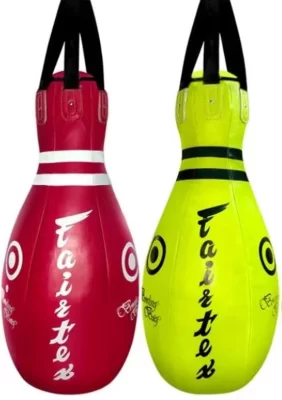
The Bowling Pin Heavy Bag is a ceiling-mounted punching bag with a unique shape designed for uppercuts, hooks, and oblique shots.
It is made of durable synthetic leather with high-density foam padding to ensure excellent shock absorption, reducing impact to the hands and wrists. It is available in 50, 80, and 120 lbs. and 3-4 feet in height, making it suitable for boxers of all skill levels. The tapered top simulates an opponent’s chin, helping boxers and martial artists improve their accuracy, knockout power, and inside fighting skills.
This bowling pin heavy punching bag is perfect for home gyms, professional training centers, and commercial locations that require a sturdy ceiling mount and reinforced chain system. It’s maintenance is simple – just wipe it with a damp cloth and check the chain regularly. It costs between $100 and $250 and is a worthwhile investment for improving striking accuracy and rotational power.
Teardrop Heavy Punching Bag – Compact and curved, excellent for clinch work and uppercuts

The teardrop bag is the first choice for Muay Thai, MMA and grappling training. Unlike standard heavy bags, its rounded shape allows boxers to practice powerful knees, elbows and close-range punches. Designed to simulate the torso of a real opponent, it helps boxers form fluid punching combinations while improving balance and control. The Fairtex Teardrop Heavy Bag and RDX Muay Thai Bag are the first choice for athletes who want to train in dynamic striking, not just basic boxing.
It is made of high-quality synthetic or genuine leather with reinforced stitching for durability. The fabric or sand-filled core effectively absorbs blows, reducing impact to the wrist and knuckles.
This bag is suspended from the ceiling with a chain system, making it best suited for a home gym or professional training facility. It requires occasional cleaning with a damp cloth to maintain durability. With prices ranging from $100 to $300, it is an affordable investment for intermediate and advanced boxers to improve their skills.
Aqua Bag (Water Bag) – Water-filled for joint-friendly striking.

The aqua bag brings a new level of impact absorption and joint protection to heavy bag training. Unlike traditional fabric-filled bags, water-filled bags distribute force more evenly, reducing strain on the hands and wrists. This makes them ideal for fighters recovering from injuries or anyone looking for a low-impact training option.
The Aqua Training Bag 120 lb. and Everlast Hydrostrike Bag are among the best choices for realistic, fluid striking with enhanced shock absorption.
Aqua Bags are available in 12-inch, 18-inch, 21-inch, and 24-inch sizes to accommodate a variety of skill levels and training needs. They are made of thick, puncture-resistant vinyl for durability and are suitable for indoor and outdoor use.
The Aqua Bag Installation requires ceiling straps or chains, and it’s maintenance is simple – just wipe it down and adjust the water level as needed. With prices ranging from $100 to $300, it is a long-term investment for those seeking a high-quality training experience with excellent shock absorption and reduced joint stress.
Pneumatic Punching Bag – Air pressure-based resistance for controlled force training.
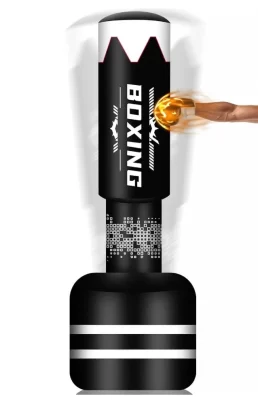
The Pneumatic Punching Bag is an advanced training tool that utilizes air pressure-based resistance to provide a customizable and controlled striking experience. Unlike traditional punching bags that rely on sand, fabric, or water to add weight, this bag’s air pressure is adjustable, allowing boxers to adjust the bag’s resistance to match their training intensity. The inflatable design effectively absorbs impact, reduces joint stress, and minimizes the risk of injury, making it a great choice for boxers who focus on precision, speed, and endurance rather than brute strength.
Designed for boxing, mixed martial arts, and general combat sports, the Pneumatic Punching Bag has a unique rebound effect that makes it ideal for reflex training, defensive training, and speed development. Adjustable resistance allows boxers to simulate different levels of punch absorption, mimicking real opponents with different defensive capabilities. Unlike traditional heavy punching bags, which become harder over time due to compaction of the fill, this bag maintains a consistent striking surface and can be easily adjusted to suit different training styles by increasing or decreasing air pressure.
High-quality synthetic leather or reinforced vinyl enhances the durability of the Pneumatic Punching Bag, ensuring it can withstand repeated blows for a long time. Some models come with built-in sensors to track punching speed and power, providing valuable data for professional boxers and fitness enthusiasts looking to monitor and optimize their training performance. Compared to traditional heavy punching bags, punching bags are lightweight, more versatile, and easier to move, making them ideal for home gyms, professional boxing facilities, and fitness centers.
With a price range of $200 to $600, air-powered punching bags are a great training tool for boxers of all skill levels. Whether you’re a beginner looking to improve your punching speed and coordination, or an advanced athlete seeking precision and control, this air-pressure-based punching bag provides you with a modern and effective training experience. Its easy maintenance, customizable resistance levels, and joint-friendly design make it a high-tech alternative to traditional punching bags, providing an unparalleled striking experience for those serious about improving their skills.
Speed Bag/ Speed Ball – Small air-filled bag for hand speed and rhythm training
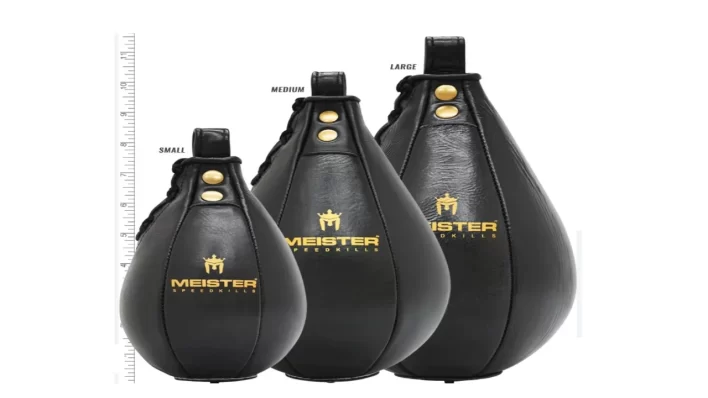
The speed bag is more than just a tool—it’s a rhythm-building machine. Designed to enhance reflexes, coordination, and hand speed, this small, air-filled bag rebounds rapidly, forcing fighters to stay sharp. Used by legendary boxers like Muhammad Ali, the speed bag improves timing, head movement, and endurance.
The Title Boxing Super Speed Bag and Everlast Elite Speed Bag are top choices for fighters and fitness enthusiasts alike, helping to sharpen hand-eye coordination while adding a fun cardio element to your routine.
Available in 6-inch, 8-inch, and 10-inch sizes, the smaller bags move faster and are good for speed training, while the larger bags are designed to build shoulder endurance. For setup, you’ll need a speedball platform and swivel stand to ensure optimal rebound control. The inflatable bladder absorbs impact and reduces hand fatigue during long training sessions.
Speed bags are ideal for boxers, mixed martial artists, and fitness enthusiasts. Maintenance is simple – wipe clean with a damp cloth and check the air pressure regularly. Priced between $30 and $150, it’s a must-have for home gyms, professional training facilities, and boxing clubs.
Double-End Bag – Suspended by elastic cords for unpredictable movement
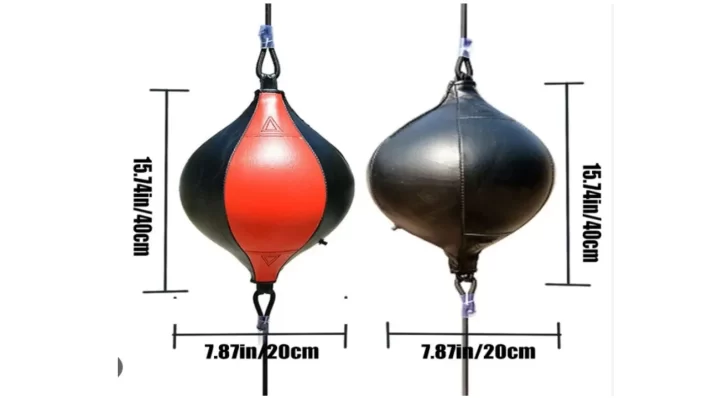
Often referred to as the “boxer’s secret weapon,” the Double-Ended Bag is an essential tool for improving counter-punching skills. Suspended between elastic cords that connect the ceiling to the floor, the bag bounces unpredictably, forcing the boxer to react, dodge and strike with precision. Unlike a speed bag, the Double-Ended Bag mimics the opponent’s movements, helping the boxer master timing, footwork and defensive reactions. Suitable for both professionals and beginners, this bag is perfect for honing your fighting instincts without the need for a sparring partner..
It requires a ceiling hook and floor anchor for installation, and comes with an adjustable cord to control the speed of the rebound. Tighter cords increase the difficulty, while looser cords make it easier for beginners.
Regularly check rope tension, clean the leather surface with a damp cloth, and replace worn bungee cords to maintain optimal rebound performance.
High-quality double-ended punching bags typically cost $30-80, making them an affordable long-term investment for any serious puncher.
Spring-Loaded Reflex Bag – Free-standing, quick-returning bag for speed drills
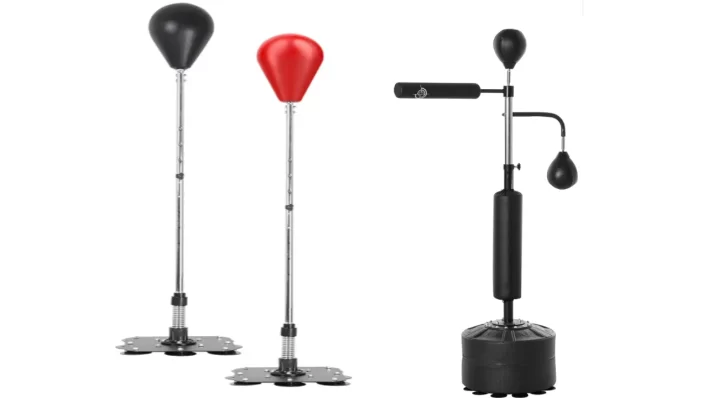
The reflex bag is built for speed, accuracy, and head movement training. Unlike heavy bags, it bounces back instantly, simulating an opponent’s counterpunches and feints. This forces fighters to react, dodge, and land precision strikes, making it an essential tool for boxers and kickboxers. Popular models like the Cobra Reflex Bag and Title Rapid-Response Bag are used by pro fighters to sharpen reaction times and defensive reflexes.
Reflex bags often have an adjustable height mechanism to allow users of different heights to train effectively. Most models range from 4 to 6 feet in height, making them suitable for both children and adults. The striking surface is usually made of durable synthetic leather or high-density foam, ensuring long-term use while providing a comfortable striking experience. The base is filled with water or sand to maintain stability during intense training sessions, but lighter models may still move slightly when hit hard.
One of the main benefits of a spring-loaded reflex bag is its ability to increase striking speed and accuracy. Unlike heavy bags that absorb punches, this bag rebounds unpredictably, forcing the boxer to react quickly. This feature makes it ideal for practicing combination punches, counters, and defensive head movements. The constant movement requires the user to maintain rhythm and accuracy while improving their footwork and defensive skills.
Installing a reflex bag is relatively simple, requiring only stable floor space, with no wall brackets or ceiling hooks required. This makes it a great choice for home gyms, small training areas, and apartment-friendly workouts. Regular maintenance includes checking spring tension, ensuring the base is securely padded, and wiping down the striking surface to remove dust and sweat buildup.
In terms of cost, high-quality spring-loaded reflex bags typically cost between $50 and $150, depending on brand, material, and adjustability features. This makes it an affordable and effective training tool for those looking to improve speed, accuracy, and reaction time. Whether used for boxing, mixed martial arts (MMA), or general fitness, spring-loaded reflex bags are a great addition to any training routine, helping athletes develop nimble hands and sharp reflexes through consistent practice.
Wall-Mounted Striking Pads – Fixed pads for targeted strikes and combinations.
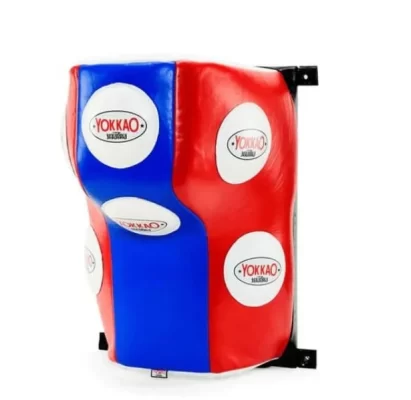
If space is limited but precision and technique are your focus, a wall-mounted bag is a game-changer. Unlike hanging bags, it stays fixed in place, allowing fighters to practice targeted strikes without unpredictable movement. Used in boxing gyms for precision drills, options like the Ringside Wall-Mount Uppercut Bag and Everlast Precision Training Wall Bag offer durable padding and realistic striking surfaces. Ideal for small spaces, garages, and home setups, this bag is a top pick for serious athletes refining technique.
These pads are typically made of high-density foam and covered in durable synthetic or genuine leather, which provides excellent shock absorption while maintaining longevity. Some models feature multiple striking zones that mimic different target areas on an opponent’s body, helping to improve a boxer’s accuracy and tactical striking skills. Unlike free-standing or hanging punching bags, wall-mounted pads do not move upon impact, so boxers can focus entirely on technique and power without having to adjust to the bag’s movement. This feature makes them particularly suitable for building muscle memory and improving striking form.
Installing a wall-mounted striking pad requires attaching it to a solid wall using a mounting bracket and screws. It is critical to mount them at the correct height for the user’s training needs, ensuring that different striking points align with natural striking angles. Many models come with adjustable mounting options, allowing the user to change positions for different exercises. Since they are fixed to the wall, they require less space than traditional heavy punching bags, so they are ideal for small training areas or home settings.
Wall-mounted pads are best suited for boxers who prioritize precision over bag movement. They help improve reaction time, counterattacks, and power control, as boxers must employ correct technique rather than relying on the bag’s momentum. Since they do not provide the swinging motion of hanging from a bag, they are not ideal for footwork or evasive maneuver training, but they excel at teaching boxers how to deliver compact and effective strikes. Many professionals use them for short-distance training, focusing on speed, accuracy, and explosiveness in combinations.
In terms of maintenance, wall-mounted striking pads require little care. Wiping the surface with a damp cloth regularly will keep it clean, and regular inspection of the mounting brackets will ensure stability during use. Over time, padding may wear out from frequent use, but high-quality padding is designed to withstand repeated impacts for many years.
Prices range from $50 to $150 for standard models, while advanced models with reinforced padding and multiple striking zones can cost more. Given their durability and ability to increase striking accuracy, wall-mounted striking pads are an excellent investment for boxers and fitness enthusiasts who want a compact, effective training tool.
Wrecking Ball Heavy Bag – Similar to a wrecking ball but swings freely.

Designed for devastating hooks, uppercuts, and body shots, the wrecking ball bag is a powerhouse for fighters focusing on short-range punching power. Unlike traditional heavy bags, its rounded shape creates a larger striking surface, allowing boxers to work on head and body combinations with ease.
It’s made of tear-resistant synthetic leather with high-density foam padding for durability and shock absorption to protect the hands and wrists. Available in 60-, 80-, and 100-pound weights, it mounts securely using a ceiling chain system for stability and reduced swinging.
The wrecking ball is used by pro boxers and heavy hitters. it’s maintenance is simple—just wipe it clean and check the chain regularly. With an affordable price range, the Ringside Powerhide Wrecking Ball and Title Boxing Body Shot Bag are excellent choices for fighters looking to increase punching efficiency and accuracy.
Slip Bag – Small hanging bag for practicing dodging and slips.
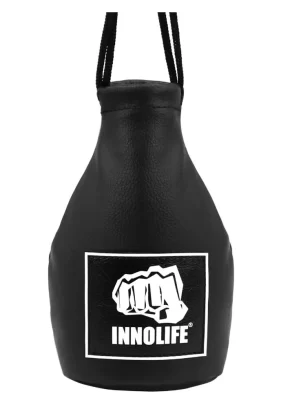
The Slip Bag, also known as a Reflex Bag or Dodge Bag, is a lightweight, compact training tool designed to improve head movement, defensive skills, and reflexes. Made of durable synthetic leather, it has a reinforced elastic cord that rebounds unpredictably when struck, forcing the boxer to react quickly and dodge incoming strikes.
Slip Bags are typically 6-12 inches in diameter and can be attached to a ceiling mount, wall mount, or double-ended anchor, making them ideal for home gyms and small spaces. Adjustable cord length allows for customized training intensity, and regular use helps develop agility, hand-eye coordination, and defensive instincts.
Mike Tyson is known to use the Slip Bag to improve his movement abilities, making it a must-have for boxers, Muay Thai practitioners, and MMA fighters. Compared to a double-ended bag, the Slip Bag focuses more on defensive moves than counterattacks.
Easy to maintain, simply wipe with a damp cloth and check the elastic cord regularly. With prices ranging from $20 to $60, top-rated models include the Ringside Slip Bag and the Title Boxing Reflex Bag.
Muay Thai Heavy Bag – Extra-long for low kicks and clinch work
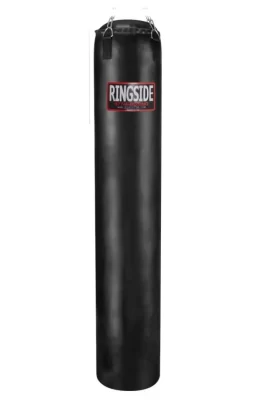
Muay Thai heavy bags are a longer and slimmer version of traditional punching bags, designed for Muay Thai, kickboxing, and mixed martial arts training. Unlike standard punching bags, which are typically 4-5 feet long, Muay Thai bags extend up to 6-7 feet, allowing fighters to practice low kicks, knee strikes, and grappling moves—all essential parts of Muay Thai fighting.
These bags are made of durable synthetic or genuine leather and reinforced with high-density foam padding to absorb powerful kicks while minimizing impact on joints. Most Muay Thai bags are filled with fabric, sand, or a mixture of both, providing dense, realistic resistance that closely resembles a real opponent.
One of the main benefits of a Muay Thai bag is its swinging action. When struck, it moves back and forth, simulating the reactions of a real opponent. This helps fighters develop footwork, timing, and accuracy, while also building explosiveness and endurance. The extra-long design also supports close grappling training, allowing fighters to grab the bag and control its movement to practice knee and elbow strikes—core aspects of Muay Thai fighting.
Mounting a Muay Thai bag requires a sturdy ceiling mount, wall mount, or a solid bag stand to support its weight, which typically weighs between 80 and 150 pounds. For those seeking a low-maintenance option, most premium Muay Thai bags are weatherproof and tear-resistant, making them ideal for both indoor and outdoor training settings.
Whether you’re a beginner or a professional fighter, a Muay Thai bag is an essential training tool for improving technique, increasing striking power, and improving endurance. Popular choices include the Fairtex Banana Bag, Twins Special Muay Thai Bag, and Outslayer Muay Thai Heavy Bag, which are highly rated for their durability and performance.
Muay Thai bags typically range in price from $150 to $300, depending on the brand and quality of the materials. Maintenance is simple, requiring only a wipe with a damp cloth after each use and checking the hanging chain or straps for wear.
Free Standing Punching Bag – Varieties designed for different martial arts and home training setups
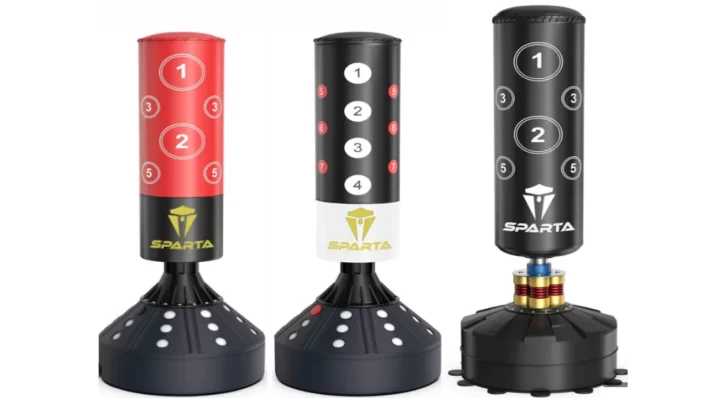
If you need a versatile and easy-to-move training tool, a free-standing punching bag is an excellent choice. Unlike hanging bags, these come with a weighted base (sand or water-filled) for stability, making them ideal for home gyms, garages, and outdoor spaces. Their design allows for quick setup with no installation required.
The Century Wavemaster XXL and Everlast Powercore Free-Standing Bag are popular picks for kickboxers, MMA fighters, and fitness enthusiasts looking for a flexible and space-saving option.
When choosing a best freestanding punching bag, consider factors such as material, height, weight, adjustability, and portability. The synthetic leather punching bag is durable, the foam core absorbs shock, and the heavy base ensures stability. Adjustable height and resistance features allow for a customized workout.
Grappling Dummy – Human-shaped dummy for wrestling and ground fighting

The grappling dummy is the ultimate training tool for MMA fighters, wrestlers, and Brazilian Jiu-Jitsu (BJJ) practitioners. Unlike punching bags, it allows athletes to practice takedowns, submissions, and ground-and-pound techniques without needing a training partner. Available in human-like torso designs or flexible limb models, options like the Century Grappling Dummy and Fairtex Maddox Dummy help fighters simulate real fight scenarios while perfecting their throws, joint locks, and transitions.
Most grappling dummies are made of durable synthetic leather or heavy-duty canvas, ensuring they can withstand repeated throws and blows. The interior is usually filled with fabric, sand, or foam, giving them a realistic feel while remaining flexible enough for a variety of wrestling moves. Some advanced models even have removable limbs, allowing practitioners to simulate joint locks, arm drags, and chokes.
Grappling dummies are available in a variety of sizes and weights, ranging from 30 pounds for beginners to over 120 pounds for professionals. Models with adjustable weights allow athletes to add resistance as they progress. Some designs even allow the dummies to stand, sit, or lie down, providing a diverse training experience.
Setting up a grappling dummy is simple—most models are freestanding and require no additional installation. For maintenance, wipe it down periodically with a damp cloth and check for frayed seams or leaking padding material. High-quality grappling dummies typically cost between $80 and $300, with premium options offering reinforced seams and realistic joint movement.
Compared to punching bags, grappling dummies provide a more realistic feel for close combat, wrestling training, and submission drills. Whether you’re a beginner or a pro, a grappling dummy is an essential investment for anyone serious about combat sports training.
Reflex Bar Punching Bag (Rotating Bar Trainer) – A bar-mounted system for defensive reflexes
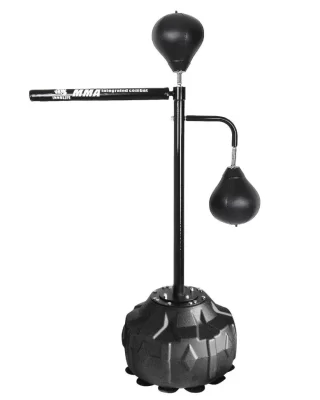
The Reflex bar Punching Bag, also known as the Spin Rod Trainer, is a unique defensive training tool designed to improve reflexes, head movement, and counter-punching skills. Unlike traditional punching bags, this system features a spinning rod attached to a central rod or stand-alone base. When struck, the rod spins rapidly, forcing the boxer to dodge, block, or counterattack in real time.
Made from high-quality synthetic leather or foam padding, the Spin Rod ensures safety upon impact while providing a realistic combat simulation. Adjustable height and resistance levels allow for customization for different skill levels, making it ideal for beginner, intermediate, and professional boxers.
Installation is relatively simple. The Reflex Bar Trainer can be mounted on a base (free-standing) or fixed to a wall or floor stand, depending on the model. Some higher-end versions include additional accessories such as speed bags, providing a more comprehensive training experience.
This tool is particularly effective for developing evasive movements, counter-punching skills, and reaction speed. By regularly training with the Reflex Bar Bag, fighters can significantly reduce reaction time and enhance defensive moves, including slips, blocks, and shoulder rolls—skills used by legendary fighters Floyd Mayweather and Canelo Alvarez.
Compared to other defensive training tools, such as slip and double-end bags, the Reflex Bar Trainer provides constant, fast-moving stimulation, making it more challenging and engaging. It is also a versatile training tool for boxing, mixed martial arts, and Muay Thai fighters, helping them hone their defensive instincts under pressure.
For maintenance, regularly inspect the rotating mechanism and padding to ensure smooth operation and durability. Most models range in price from $80 to $200, depending on features and build quality. Some of the most recommended models include the Ringside Reflex Bar Trainer and the Everlast Rotating Bar System.
With its dynamic movements, real-time reaction training, and compact size, the Reflex Bar Bag is a must-have tool for any fighter looking to take their defensive skills and reaction speed to the next level.
Body Opponent Bag (BOB) – Realistic Training Tool for Fighters
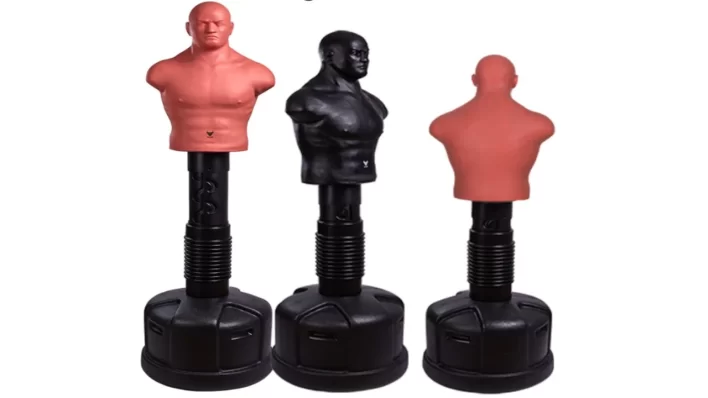
The Body Opponent Bag (BOB) is a life-like, free-standing punching bag designed to simulate a real opponent. It is made of high-strength plastisol and a high-density polyurethane foam core to provide a realistic striking experience while ensuring durability. Adjustable height (60″ – 78″) allows for precision training, making it ideal for boxing, mixed martial arts, and self-defense practice.
Unlike traditional heavy punching bags, the BOB does not require a ceiling stand and features a sturdy, padded base for stability. Its anatomical structure allows boxers to target specific areas such as the head, ribs, and torso, which increases precision, accuracy, and technique improvement.
The BOB is easy to maintain, requiring only occasional cleaning and inspection of the base. Top-of-the-line models, such as the Century BOB XL, cost between $250 and $400 and offer an extended torso for better body-punching training. Perfect for fighters, martial artists, and self-defense practitioners, the BOB can enhance real-world fighting skills in a way that standard punching bags cannot.
Tire Heavy Bag – Made from stacked tires, great for durability and cost savings
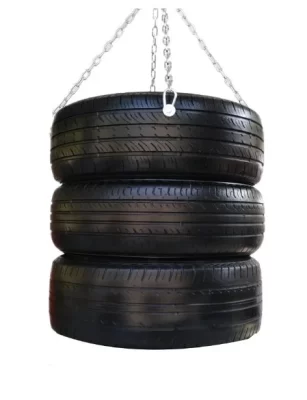
The tire punching bag is a unique and affordable alternative to traditional punching bags. Made from stacked recycled tires, it offers unmatched durability, resistance, and cost savings. The sturdy rubber material can withstand heavy blows, making it a great choice for boxers, kickboxers, and martial artists who need a long-lasting training tool.
Unlike standard punching bags, tire punching bags do not need to be refilled frequently because the rubber structure naturally absorbs impacts while retaining its shape. This makes it ideal for power punchers who want a sturdy, durable punching bag that won’t wear out over time. Its solid rebound effect can also help boxers develop stronger punches, greater accuracy, and better endurance.
One of the main benefits of the tire punching bag is its customizability. Users can stack two to four tires to create a punching bag that fits their preferred height and resistance level. The punching bag can be mounted horizontally or vertically using chains, ropes, or metal frames, providing a flexible setup for different training styles. Heavier equipment is ideal for strength and conditioning training, while lighter equipment is suitable for speed and precision training.
From a sustainability perspective, tire heavy punching bags recycle old tires and are an environmentally friendly choice. They are also highly weather-resistant, making them suitable for outdoor training without worrying about material degradation.
Maintenance is minimal—just wipe the tire with a damp cloth to remove any dirt or dust. The chain or suspension system should be checked regularly to ensure stability and safety. With a price range of $0-50 (if using a repurposed tire), this is one of the most affordable punching bag solutions available that you can make at home. Learn from the following video:-
Compared to traditional heavy bags, the tire weighted bag offers more resistance, making it more suitable for strength training rather than fluid striking exercises. It is widely used in Muay Thai, boxing, and MMA gyms, especially for calf training, power punches, and elbow strikes.
For fighters looking for an indestructible, affordable, and effective training tool, the tire weighted bag is an excellent investment that combines practicality and sustainability.
Uppercut Bag – Specialized for uppercut drills.
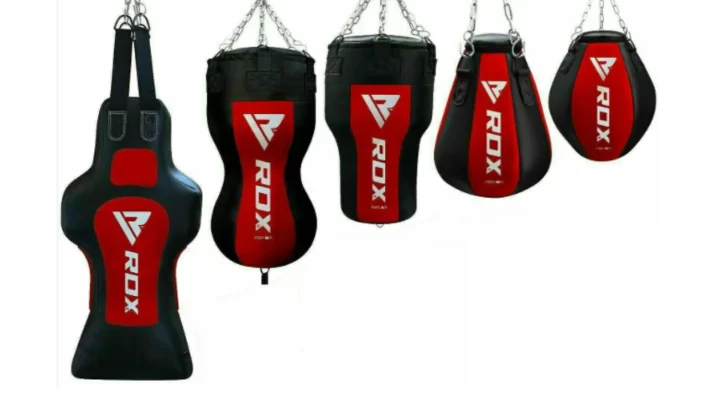
Mastering the uppercut requires not only raw power, but also precision, finesse, and control. The Uppercut Bag is designed to help boxers perfect their short-range punches, including uppercuts, hooks, and tight combinations. Unlike traditional heavy bags, this bag is tilted or wall-mounted, allowing boxers to practice realistic strike trajectory without overextending. Whether you’re training for close combat or improving your accuracy with body shots, this bag is an essential tool for boxers who rely on explosive inside strategies.
Made from durable synthetic leather or reinforced vinyl, the Uppercut Bag features high-density foam padding that absorbs hard blows while protecting a boxer’s hands and wrists.
In terms of mounting, the Uppercut Bag can be mounted on a wall, attached to a standalone unit, or as part of a multi-angle bag setup. Some models, like the Ringside Wall-Mounted Uppercut Bag, offer adjustable height options, allowing boxers to customize their training experience.
Care for an uppercut bag is simple – wipe it with a damp cloth after use to prevent sweat buildup, and check the mounting fixture regularly for stability. Prices typically range from $50 to $200, depending on brand, size, and mounting type. Popular models include the Ringside Uppercut Bag, Everlast Wall-Mounted Uppercut Bag, and Title Boxing Angled Heavy Bag.
Punching Bag Comparison Table
Below is a quick comparison of the most popular punching bag types, highlighting their best use cases, training benefits, and ideal users.
| Punching Bag Type | Best For | Key Benefits | Ideal Users | Installation | Common Filling |
|---|---|---|---|---|---|
| Heavy Bag (Hanging) | Boxing, Muay Thai, MMA | Power, endurance, technique | Beginners to pros | Ceiling/wall mount | Compressed fabric, sand |
| Free-Standing Bag | Home training, kickboxing | No installation, versatile use | All skill levels | Weighted base (sand/water) | Foam, air core |
| Speed Bag | Boxing, hand-eye coordination | Improves reflexes & timing | Boxers, fitness users | Swivel-mounted | Air-filled bladder |
| Double-End Bag | Reaction time, counter-punching | Fast movement, defense drills | Intermediate to advanced | Ceiling-to-floor cords | Air-filled bladder |
| Uppercut Bag | Close-range striking, uppercuts | Improves hooks & inside game | Boxers, MMA fighters | Wall-mounted or angled | High-density foam |
| Teardrop Bag | Clinch work, knee strikes | Best for Muay Thai & MMA | Kickboxers, Muay Thai fighters | Ceiling mount | Fabric, sand |
| Wrecking Ball Bag | Head & body shots, power strikes | Great for heavy punchers | Boxers, power hitters | Ceiling mount | Fabric, sand |
| Aqua Bag | Reducing joint strain | Softer impact, joint-friendly | Boxers, fitness users | Ceiling mount | Water |
| Grappling Dummy | MMA, Brazilian Jiu-Jitsu (BJJ) | Takedowns, ground training | MMA fighters, wrestlers | Free-standing | Fabric, foam |
| Wall-Mounted Bag | Precision punching | Fixed position, accuracy drills | Boxers, MMA fighters | Bolted to a wall | Dense foam |
| Reflex Bag | Speed, head movement | Simulates real opponent reactions | Boxers, MMA fighters | Free-standing | Air core, foam padding |
How to Use This Table?
- If you’re training for boxing, a heavy bag, speed bag, or double-end bag are great choices.
- If you need MMA or kickboxing practice, go for a teardrop bag, grappling dummy, or reflex bag.
- For home training, a free-standing bag or wall-mounted bag offers convenience and space-saving benefits.
How to Choose the Right Punching Bag
When choosing a punching bag, consider the following:
- Training Goals – Do you want to focus on strength, speed, endurance, or technique?
- Space Availability – Do you have room for a hanging bag, or do you need a free-standing option?
- Skill level – Beginners may prefer a lighter, more forgiving bag, while advanced boxers may need a heavier, denser bag.
- Budget – Prices vary by material, size, and brand, so choose a bag that fits your budget.
Check out our detail Punching Bag Buying Guide
FAQs About Punching Bags
Punching bags are used in combat sports, fitness training, and rehabilitation to improve strength, coordination, endurance, and technique. They provide a target for strikes like punches, kicks, and knee strikes, helping athletes and fitness enthusiasts develop skills and power.
There are different types of punching bags because each one serves a unique purpose in training. Some are designed for building strength, others for improving speed and reflexes, and some are specialized for certain types of strikes or training styles. Choosing the right bag ensures the most effective training for your specific goals.
Heavy punching bags are primarily used for developing strength and power. They provide resistance when struck, helping fighters and athletes build muscle and improve endurance, making them ideal for punching, kicking, and practicing combinations.
Hanging heavy bags are suspended from a ceiling or frame, allowing them to swing when hit. They provide a more realistic experience by mimicking the movement of an opponent. Freestanding heavy bags, on the other hand, have a solid base that can be filled with water or sand, providing a stationary target. Freestanding bags are easier to move but don’t provide the same swinging motion as hanging bags.
Speed bags are small, round bags mounted on a platform that bounce rapidly when struck. They help improve timing, rhythm, and hand-eye coordination, making them a great tool for improving punching speed and precision.
Speed bags bounce quickly when hit, forcing the boxer to react fast and accurately. This helps enhance reflexes, as the athlete must adjust to the bag’s rapid movement, and improves hand-eye coordination by training the body to strike in sync with the bouncing bag.
Double-end bags are anchored at both the top and bottom, allowing them to move in multiple directions when hit. They are effective for boxing because they help improve accuracy, timing, and footwork, simulating the unpredictable movement of an opponent.
The unpredictable movement of the double-end bag challenges a boxer to adjust their punches and positioning quickly. This improves both their accuracy in landing punches and their ability to move efficiently in response to an opponent’s actions.
A wrecking ball punching bag is a round, single-point suspended bag that is ideal for close-range combat training. It is used by fighters looking to improve short-range strikes like uppercuts and hooks. It’s best for experienced fighters who want to focus on precision and control in tight spaces.
Unlike a heavy bag, which is large and swings freely, a wrecking ball bag is smaller and hangs from a single point, offering a more controlled and focused target for close-range strikes. The wrecking ball bag helps improve accuracy and timing for punches in tight spaces, while the heavy bag is better for full-body strength and endurance training.
Teardrop punching bags are designed with a unique shape that helps simulate real fight movements, making them ideal for Muay Thai and MMA. Their design provides a target for uppercuts and knee strikes, which are crucial moves in these combat sports.
The teardrop shape of the bag mimics the contours of a human body, allowing athletes to practice striking at various angles. This makes them perfect for improving uppercuts, hooks, and knee strikes, which are key techniques in Muay Thai and MMA.
Punching dummies are lifelike training tools designed to simulate human opponents. They provide a more realistic experience compared to traditional punching bags, helping athletes practice strikes, combinations, and defensive techniques in a more dynamic environment.
Punching dummies can be better than traditional hanging bags for fighters who want to simulate a real opponent’s body. While hanging bags are great for strength and endurance, punching dummies offer more realistic feedback for practicing specific strikes and movements.
Specialty punching bags include body opponent bags (BOBs), reflex bags, and bags designed for specific strikes or kicks. These bags are designed for specialized training and offer unique features that target specific skills or needs.
For home training, a reflex bag or punching dummy is often the best choice. These bags are compact, easy to set up, and provide versatile training options without taking up too much space.
When buying a punching bag, consider your training goals (boxing, MMA, fitness), skill level, available space, and whether you prefer a hanging or freestanding option. Think about how often you’ll use it and how much room you have at home for setup.
For beginners, a freestanding heavy bag or a punching dummy is a great choice. These are easier to set up, don’t require mounting, and provide good resistance for improving basic skills.
For home use, a freestanding punching bag or a punching dummy is typically the best option. These bags are easier to store, don’t require installation, and are suitable for both beginners and advanced users.
Boxing: A hanging heavy bag or speed bag is ideal for building power and improving speed.
MMA: Teardrop bags or double-end bags are excellent for practicing a variety of strikes.
Fitness: A freestanding heavy bag or reflex bag is great for overall fitness and cardio workouts.
Home Use: Freestanding bags or punching dummies are easy to set up and take up less space.
For beginners, a freestanding punching bag or a lightweight hanging heavy bag is ideal. These are easy to set up and provide a balanced level of resistance for training.
Freestanding Bags: Portable and require no installation, great for home workouts.
Hanging Bags: Require a ceiling or wall mount, offer better swing and resistance for advanced training.
A hanging heavy bag is the best choice for boxing as it provides realistic movement, swing, and impact resistance, helping with power and endurance training.
Speed bags help improve hand-eye coordination, timing, rhythm, and reflexes, making them essential for boxers and martial artists.
Water-filled bags, such as Aqua Bags, absorb impact better, reducing joint strain, while sand-filled bags provide a firmer and more traditional resistance. Also Learn about Soft Filled Heavy Bag vs Traditional Heavy Bag: Which One Should You Choose?
A good rule is to choose a bag that’s about half your body weight.
– 40–70 lbs: Light training, beginners.
– 80–100 lbs: General fitness and boxing.
– 100+ lbs: Professional and heavy hitters.
Yes, learn about our detail guide about How to Setup Your Punching Bag Space?
Final Thoughts
Now that you know the different types of punching bags, it’s time to choose the one that matches your training goals. If you need power and endurance, go for a heavy bag. Want to improve speed and accuracy? A speed bag or double-end bag will be your best bet. Need realistic sparring practice? A grappling dummy or reflex bag can simulate a real opponent.
No matter what your sport—boxing, MMA, Muay Thai, or fitness—there’s a perfect punching bag waiting for you. Take your training to the next level by picking the right bag today!
Which punching bag do you prefer? Let us know in the comments!



